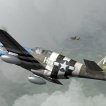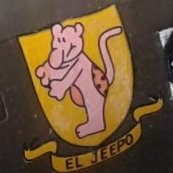

Jerry Crandall
Members-
Posts
36 -
Joined
-
Last visited
Jerry Crandall's Achievements

Newbie (1/9)
87
Reputation
-
A few weeks ago this subject came up again on Hyperscale and resulted in a very lengthy discussion. You might want to check it out. The bottom line is I showed the DVD at the IPMS convention in Las Vegas and all of the viewers were convinced that the the checkers on the the cowlings of theses Fw 190s of 2./JG 1 were red and black. Cheers, Jerry
-
Erich Sommavilla said this was a G-6 that was assigned to Hartmann and Sommavilla took a newer G-14. The men were not happy that Hartmann was brought in to take over the unit feeling the position should have been given to one of their own. That why he was issued an older type. A lot of I./JG 300's Bf 109 G-6s had the battery box mounted in the cockpit. Cheers, Jerry
-
I've seen many propeller blades from Focke- Wulf D-9s and a few wooden VDM 9-12176 A blades from late A-8s and A-9s. They are all RLM 70 Black-Green. Cheers, Jerry
- 8 replies
-
- 10
-

-

-

what are some good book regarding the Fw 190 D?
Jerry Crandall replied to aurelien wolff's topic in Aircraft WWII
You are correct, The term RLM 84 was tagged on to this light green color by an American author years ago when he assumed the next in line number for a camo color would be 84 so he chose that number for easy reference. Several Dora 9s recovered had this light green painted over the original RLM 76 Light Blue. We have a oval panel from a JG 6 A-8 that was originally 76 and was panted over with light green. Cheers, Jerry -

what are some good book regarding the Fw 190 D?
Jerry Crandall replied to aurelien wolff's topic in Aircraft WWII
There are color photos ,film and many existing samples of light green samples on Fw 190s ,Dora 9s etc. and even He 111s. It was an undersurface color that was used toward the end of the war. We have many samples in our collection . The He 219 in the NASM collection has a wavy pattern of original light green on the upper surfaces. It is not a altered or faded form of another color. Cheers, Jerry -

what are some good book regarding the Fw 190 D?
Jerry Crandall replied to aurelien wolff's topic in Aircraft WWII
Graham, The label "RLM 84" was not my invention. That came from an American author years ago but not me. Cheers, Jerry -

what are some good book regarding the Fw 190 D?
Jerry Crandall replied to aurelien wolff's topic in Aircraft WWII
It's amazing how things get twisted around about these colors. First, I said I have a slide with a sliver of dark green color from a WWII Italian pant company that is marked 83. There is no documentation that the late war light green that was a common under surface color has anything to do with RLM 76 Light Blue. That is someone's theory. There is evidence those colors were used together. Again the big problem is we only a fraction of documents dealing with late war colors. The best source is recovered aircraft that has remaining color. Cheers, Jerry -
The photo of Schröder standing on the the port wing of "Red 19" shows the inscription Kölle alaaf now with an exclamation point added possibly the same time the camouflage was altered on the starboard side and the red band was applied. It appears there is no change to the camo but the EZ 42 gun sight can be seen. Unfortunately, the photo does not show if the red band has been applied. So there is no easy answer. Cheers, Jerry
-
The red on the fuselage band is a darker red than the "Red 19". So far no one knows for sure what the formula was. It could be RLM 45 Red Oxide primer or a unit mix. On the 25 or 26 of November the camouflage was altered along with the name Edelgard. Also the canopy was a late 8-190.122 style without the pulley system. Ernst complained about that, as since the aerial wire did not retract it was constantly slapping on the rear metal part of the canopy in the wind and scratching the paint off. In addition the new EZ 42 gun sight was installed. After Schröder's crash landing in "Red 19" it was repaired and was issued to I./JG 301 with the number , slogan and name over painted. Cheers, Jerry
-
This A-8 did not have the upper wing fairings as seen in the photo. Not all A-8s had these fairings including Dortenmann's well known"Red 1" from JG 54. Of course they were necessary when the MK 108 30mm cannons were mounted in the outer wing(R2). Cheers, Jerry
-
The Focke Wulf factory handbook states the weight of camouflage paint for the A-8 is 4.4 pounds. Ross Finlayson , a Canadian Mosquito pilot, is the person that took the great photos of "Yellow 10" when an American pilot ferried it into Gilze-Rijen airbase in Holland. He told of the interest of he and his pilot friends climbing all over this rare German fighter and somehow they dislodged the pilots seat and left it on the cockpit ledge. Of course, the American pilot was not happy about that. Ross gave me the all of the photos and negatives that he took, which I still have, plus his description of the camouflage colors. Without those photos we would know very little about the camo and markings of "Yellow 10". Cheers, Jerry
-
Years ago we were asked to come the USAF museum and give them information to correct the spurious camo and markings on their D-9. When I asked them how they determined the colors they said they found medium gray (RLM75) on the airframe. At this time they had the D-13 wings with fuselage from D-9 W.Nr. 601088. The technician that was to head up the project retired shortly thereafter and to this day it remains in the incorrect markings of a IV./JG 3 a/c. By the way, I did not paint the D-13. I did supply them with photos, color chips and diagrams but their crew painted it. The paint was applied too thick and to heavy. The paint on "Yellow 13" was lightly fogged in many areas. Cheers, Jerry
-
The black and white photo of W.Nr. 836016 doesn't change anything especially when we saw some of the original colors on "Yellow 10" and I still have some parts with color. So the problem is, we don't know the colors on 836016. We can only guess. As far as the Hakenkruez it's appears the placement is odd so who knows . Allied capture documents describe the one on "Yellow 10" as being black with a white outline but they maybe referring to markings reapplied by the Americans. Cheers, Jerry
-
Hi Guys, Interesting discussion forum on "Yellow 10". My first contact with my girl was in 1965 when the owner took us to the vacant lot and there it was . We were amazed that it hadn't been stolen or severely vandalized, although a local drunk had recently chopped off the supercharger scoop. The wings of the Bf 109G 10 that he also owned, had been scrapped. The friends that were with me were avid modelers and we spent hours examining the remaining paint. Of course I came back to visit constantly until the owner died and it was sold. The new owner and I were friends and we spent many weekends playing airplanes with her. At one point the owner wanted to repaint it. We spent a lot of time sanding and scraping areas to find the original paint. It had been over painted at some point after capture with American paint. Fortunately it was a light coat and came off rather easily. He gave me some interesting parts with fragments of the original German paint. At that time the reason for the JG 53 emblem was unknown. Someone suggested it was an "aces" machine. Don't forget this was 1965,1966. My friend eventually had to sell it, so Doug Champlin bought it, thankfully. When Doug sent it to Germany for the first restoration we followed it and was there to see the aluminum skin stripped of all paint. They gave us some non critical parts which I still have. I can't say with certainly that the factory painted it in the sequence that we supply in my book, that's the way we suggest a modeler apply the paint. We do know however those were the colors applied. Obviously, the JG 26 technicians had a field day putting their final touches to the Kommodore's personal Dora. Cheers, Jerry




